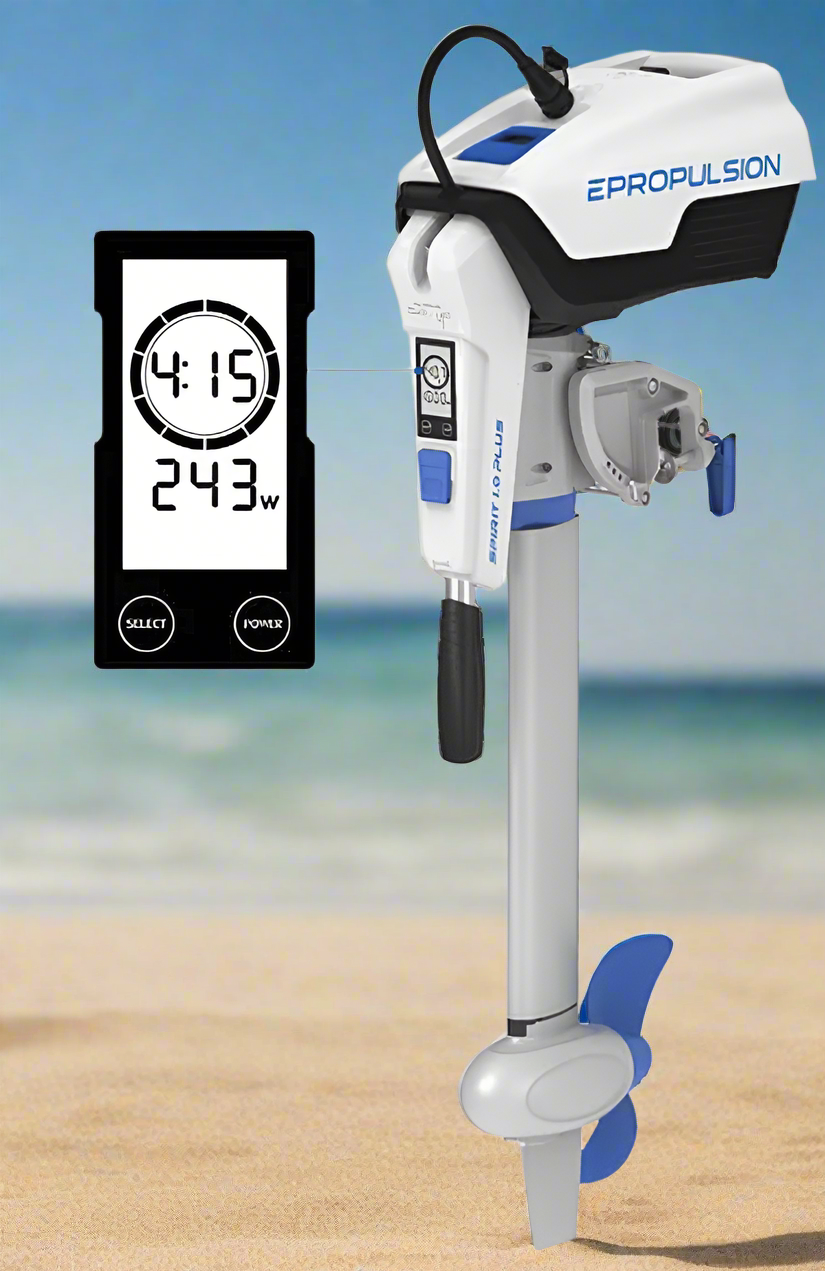ePropulsion Pod Drive 6.0 Evo electric pod motor 6 kW
ePropulsion Pod Drive 6.0 Evo electric pod motor 6 kW
Can be viewed working in our showroom.
- Promotion: 3-year warranty when registered with ePropulsion.
The Pod Drive 6.0 Evo from ePropulsion has the following advantages:
- Space-saving (not in the boat)
- Silently
- Maintenance-free
- Seawater resistant
- No cooling required
- Better than an outboard motor
- Hydrogen generation; charges the battery faster while sailing or sailing with a folding propeller.
-
POD motor benefits: Pod drives are direct-drive, maintenance-free electric motors for sailboats and small craft. They are space-saving and maximize your cabin space.
Furthermore, POD motors offer efficiency gains of between 15 and 30 percent compared to inboard motors. Because they extend below the waterline and face straight forward, there's no efficiency-reducing shaft angle, unlike inboard motors. This means thrust is directed in a straight line. Less power, and therefore less fuel consumption, is required to propel a boat at the same speed compared to inboard motors. - As a steerable pod motor, for example by mounting in the rudder blade.
-
Optimal performance: Epropulsion Pod systems ensure optimal sailing characteristics, based on thorough development to achieve minimal water resistance.
Originally developed for the Spirit 1.0 and Navy 3.0, the Pod Drive systems offer all the benefits of traditional ePropulsion outboard motors and more. Epropulsion has developed user-friendly features that deliver an exceptional boating experience from installation to operation. - Comparable to a 10 hp (propulsion power) to 15 hp (thrust) combustion engine.
- The motor is suitable for boats weighing 2,600 to 5,400 kilograms, reaching cruising speed and boats weighing between 950 and 1,900 kilograms at hull speed . Is your (sailing)boat lighter? Then consider the ePropulsion Pod Drive 3.0 Evo electric pod motor. For heavier boats, the Torqeedo Cruise 12.0 FP 12 kW is available, or you can install two pod 6 motors.
- From a similar engine Navy 6.0 We have included some test reports (sailing time and distance).
- Excluded: Battery: minimum 125Ah. For a 2 kWh consumption and 4 hours of cruising, consider an 8 kWh battery. Recommended: ePropulsion E80 LiFePO4 battery 4.1 kWh 48V, or two E80 batteries, or three E40 batteries. A single E80 battery is also possible, but this will result in a maximum of 3.9 kW of power. More affordable AGM or other LiFePO4 batteries are also available.
- Remote control not included:
- ePropulsion Navy, Pod Drive, Spirit Evo Remote top of remote control or
- ePropulsion Side Control Spirit Evo, Navy Evo and Pod Drive Evo or
- ePropulsion Evo Dual Remote Control
-
Review: I've never heard of the pod drive that works with a 32-ft sailboat. I thought it's only available for the large yacht like Volvo Penta. My cousin shared ePropulsion Pod Drive 3.0 to me when I was working on the configuration of my new sailboat.
Holger Grünfeld, Pod Drive 3.0 owner from Germany
- Subsidy : Electric boat motors and lithium batteries are eligible for the Environmental Investment Deduction and the Arbitrary Depreciation of Environmental Investments for commercially used vessels. With the MIA/Vamil, the tax benefit can amount to over 14% of the investment amount.
SPECIFICATIONS
- Item number: P6-0000-E0
- EAN: 6971312631883
- Power: 6 kW
- Motor weight with controller box: 12 kilograms
- Motor dimensions (L x W x H): 298 x 80 x 465 mm
- Includes: 3-bladed aluminum propeller: 32 cm x 22 cm ( 12.6″ × 8.7″) Item number: P6-M001-00
- Propeller rotations: 1,500 rotations per minute
- Static propulsion power: 1,080 N / 243 lbs
- Tail length 351 mm
- Drive: Infinitely variable
- Includes: 5 meter communication cable and driver module
- Steering via attached rudder (or possibly mounting 2 Pods on either side of the boat).
- 48 Volt / 62.5 Ampere
- Input Voltage: 39 Volt - 60 Volt
- Brushless DC direct drive motor, therefore low maintenance
- Maximum overall efficiency: 55%
- Rotation speed: 2,300 revolutions per minute
- Operating temperature -25°C to 50°C
-
The mounting pad is divisible so you can create two depth settings. Make sure the propeller rotates sufficiently freely from the hull to prevent excessive cavitation.
During installation, apply plenty of Sika 291 sealant around the center pipe (on the base plate, where the cables run), along the outer edge of the base plate, and between the flange and the motor. Mounting template. - Manual
- Technical drawing
- Option: Folding Propeller. To reduce drag from the boat's propeller while sailing, folding propellers are used, especially on competitive sailing vessels. Dimensions: 13.4" x 8.5", Material: NAB (nickel aluminum bronze), Number of blades: 2, Product number: P6-LU01-00
-
Option: Dual control for 2 motors. With the Evo Dual Remote Control, you can control two motors with a single motion using sync. It's also possible to control the two motors independently.
With an adjustment it is also possible to provide 1 pod with a left-turning propeller.
The integrated 4.3-inch (11-centimeter) display provides real-time information, including battery status, remaining range, speed, power, and error messages (separately for both motors). Item number: NE-DR00-00 EAN number 6971312631920. €795, including communication cables. Manual .
Customer Report:
How it all started:
First, let me introduce myself. My name is Peter Volken Smidt. I'm a professional designer, father of three daughters, and live with my family in Rotterdam near Kralingse Plas lake. I've been an avid water sports enthusiast since my early childhood, and I always said, "I'll buy a boat with my first salary."
Unfortunately, that didn't work out, but now that my daughters are old enough to swim, I decided in 2019 to look for an affordable sailboat. And I found one, and what a one! A neglected Contest 30 from the 1970s. It meets my needs perfectly. It's a fixer-upper with enough sleeping accommodations to eventually take her on vacation, enough DIY to make my designing heart beat faster, and an old Volvo Penta diesel engine with a leak in the cooling element. I'm temporarily having the engine rebuilt upon purchase so it can reach its home port.
I'm working hard to spruce up the boat, all of my efforts. The paint on the polyester hull is in poor condition, the underwater hull desperately needs new antifouling, and all the electronics on board date back to the era when incandescent light bulbs were the norm. The wiring is old and worn.
I'm enthusiastically embarking on the refit of my new dream boat. The 30-footer is being completely stripped of its old paintwork and then rebuilt with modern paint systems. Inside, the tangle of old electrical wires is being replaced with new, safe wiring; LEDs are now the order of the day. Navigation, AIS, wind indicators, NMEA 2000 data cables—the whole package is slowly but surely turning the boat into a truly modern vessel. But there's still one thing nagging at me: the engine. Although the purchase order was to fix it up so we could reach Rotterdam, I don't trust the 40-plus-year-old engine. It smokes, stinks, and overheats far too quickly.
My enthusiasm for the boat remains undiminished, so I decide to invest in a different propulsion system. Unknowingly, my search for a new propulsion system begins with traditional engine suppliers. Because the current Volvo engine is apparently very compact with a short distance between the gearbox, I quickly realize that a standard diesel engine won't fit in the current position on the boat. I also notice that the suppliers aren't very enthusiastic about the conversion project. This, infuriatingly, gets me thinking.
Slowly but surely, I'm realizing that old-fashioned diesel can no longer be the fuel in my boat. I want to switch to a sustainable alternative. Something I can install myself, that saves space, and is maintenance-free.
Low stock: 1 left
Couldn't load pickup availability
Share




































































































